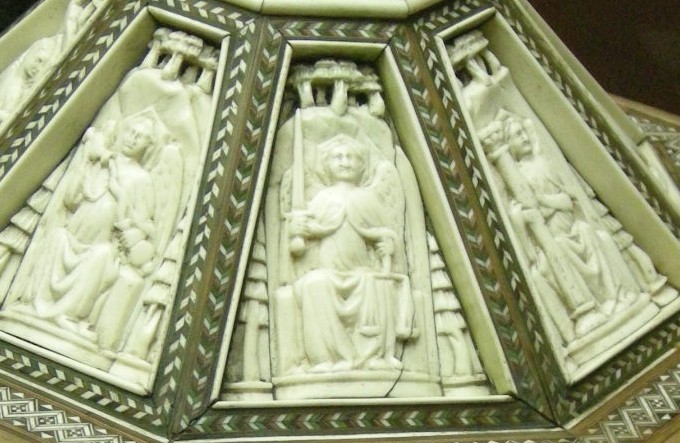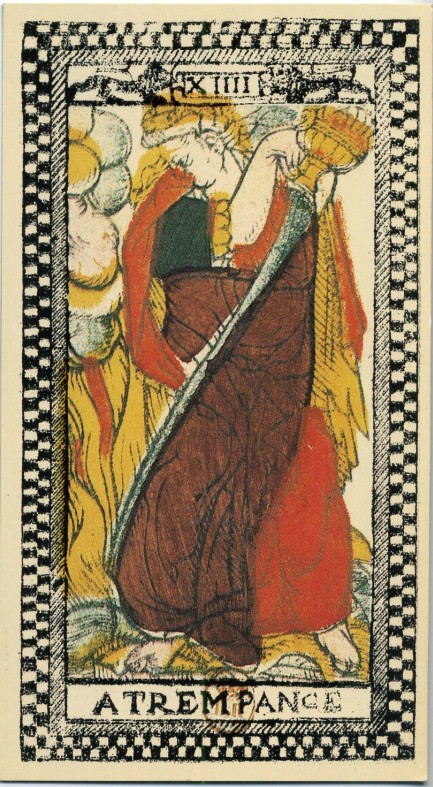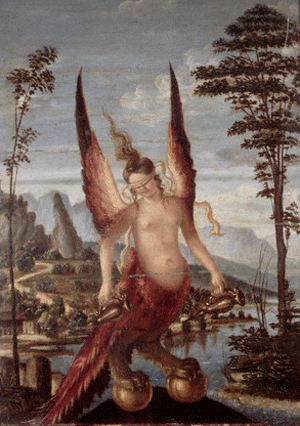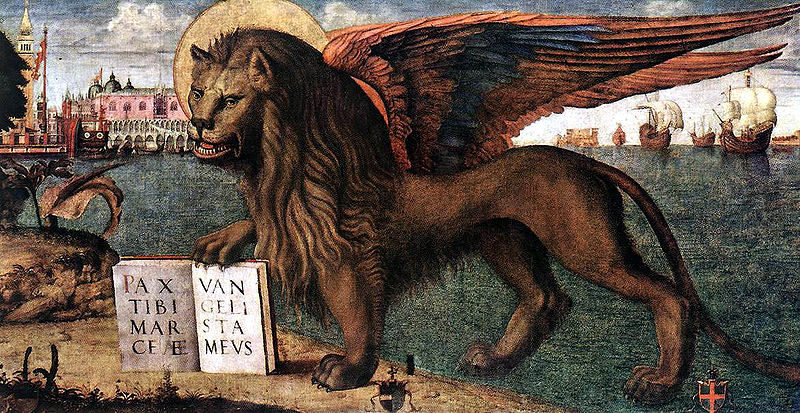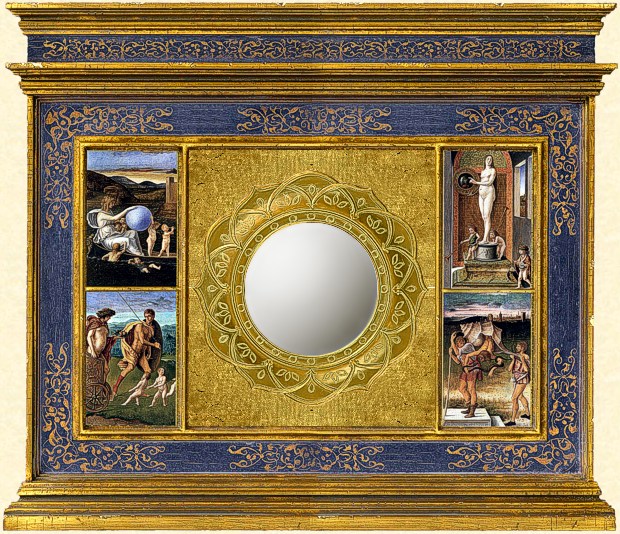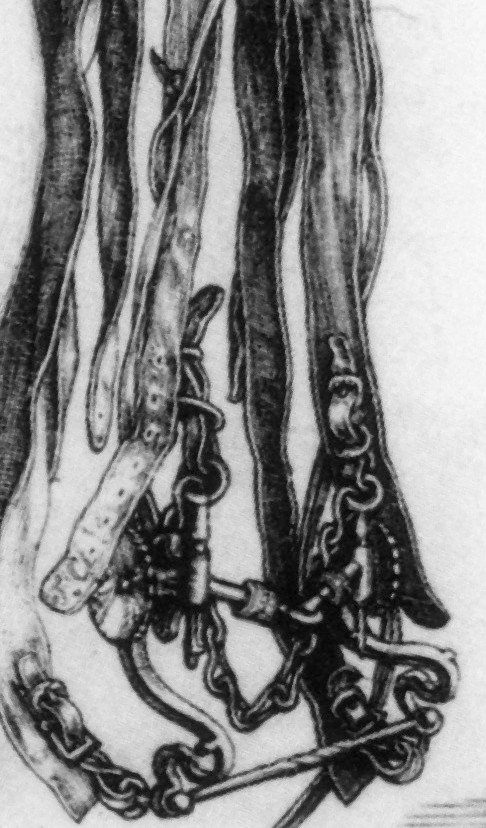Lorredan wrote:
Fancy that ..all because of Huck and his winged or not Temperance!
~Lorredan
Yes, I collect these "winged virtues". For the moment I see ...
1355 ... winged Caritas in Bologna (? influenced by Milan)
1330 - 1450 ... 4x winged Spes in Florence
15th century ... 3x winged Temperance in Venice
1560 ... winged Fortitudo in Breughel picture
1565/75 ... winged Temperance Majolica in Faenza (? possibly influenced by Venice)
1650 ... winged Temperance in Noblet Tarot
1700 etc. ... winged Temperance in Marseille and Besancon Tarot
...
well, occasionally "all virtues are winged" (Beham)
...
NORMALLY virtues are NOT winged. NORMALLY there are 7 seven or 3 theological or 4 cardinal virtues presented ... but often enough it's different.
The painters arranged them according current interests ... a very common behavior.
If we take this as an example ...

with a very large picture here ...
http://www.jura.uni-mainz.de/kube/Datei ... i816kb.JPG
from
http://www.jura.uni-mainz.de/kube/167.php
... then we have the interest to present "good government" (Siena 1337-1340 by Ambrogio Lorenzetti)
We have the 7 virtues in the right upper details, 3 theological virtues above and 4 cardinal virtues below, but the virtues are flanked by other figures "Pax" and "Magnanimità", so one easily could imagine, that there are 9 virtues. Then we've an extension at the left side with a Sapientia above, and a larger second Iustitia below, which makes some actions, which present further details of the theme "good government" with a major participation of the allegory Concordia.
The simple conclusion is, that the pictures informs us, that a good Justice would be of great importance for the "good government" and would lead of the Concordia of the people.
So virtue images are made for specific intentions. Likely we would find in a city council more pictures of Justice and in military institutions more presentations of Fortitudo. The local preferences likely had a trivial logic.
On the picture of the "good government" Justice is technically elevated by a double appearance, and the second figure is larger than the others.
The "wings" of the virtues or an indicated relation between a virtue to "Fame" (as observable to Prudence in some Trionfi card versions) likely have to be counted to be made with a similar intention.
We've even an elevation of a specific virtue through "missing presence". In such presentations it is intended to honor a specific person (the host or the owner of the representation place), who is thought to incorporate the virtue as a living example. So it was done with Borso d'Este, who had a favor for Justice.
*********
So I attempt to keep the discussion "low" and do not search for a very "complicated reason".
Well, I searched for a special relevance of Temperantia in Venice in 1513-1525, cause this might have been a time, when a Venetian "Temperance with wings" might have influenced a French "Temperance with wings", cause Venice and France had a surprising alliance in these years, after Venice and France as part of the war of alliance of Cambrai (1508-1512) had heavy war activities against each other short before.
**************************
Venice had 3 times "Temperance with wings". Two of the objects are rather small ..
..., both are rather similar (flanked by two trees, six-corner halo) and both are from the same Venetian workshop, made from bone or horn. Here's a report to the work-shop with lots of pictures.
http://www.mashpedia.fr/Baldassare_degli_Embriachi
Composition of such small bone objects could get considerable dimensions:
The most famous work, made for Giangaleazzo Visconti (a triptychon for the Certosa di Pavia) and documented for 1400-1409.
It seems, that such objects could serve as models for larger objects. Naturally the founders and sponsors of gigantic church projects (the realization took centuries) desired to see, how the final project might look like. And naturally the finally realized project often looked different than the model. Perhaps pictures like this ...
http://a-tarot.eu/p/goldschmidt/queen-castle.jpg
... were inspired by such really existing models.
But these many-figures-objects naturally made single motifs disappear. Could we assume, that a single figure would get such a big influence?
Not impossible. French soldiers robbed a lot of treasures in Italy, and naturally such objects had a good chance to wander to French collectors.
The two pictures (their context is not clear) might have been taken by such an object:
http://www.beyars.com/de_elfenbein-spae ... alter.html
The German text of the webpage gives the information, that the Embriachi family came from Genova, developed in Florence and finally settled in Venice. They also worked Jean Duc de Berry, who gave it to an abbey in Poissy.
Ein weiteres Hauptwerk der Embriachi ist das von Jean Duc de Berry dem Kloster von Poissy gestiftete große Retabel (H. 267 cm, B. 236 cm), das sich heute im Musée du Louvre in Paris befindet.
*****************
.... ha,
GREAT FINDING
http://upload.wikimedia.org/wikipedia/c ... 722_02.JPG
A detail of the above link:
from the webpage
http://it.wikipedia.org/wiki/File:Botte ... 722_02.JPG
"Bottega degli embriachi, cofanetto, metà del XIV sec., inv. 722"
Museo civico medievale (Bologna)
That's a 3rd "Winged Temperantia in bone" ... not just another picture of one of the other objects.
Please note, that also Justitia is "winged". I'm not sure about Fortitudo, but it seems, that it is also winged.
******************
... and another
great finding ...
http://upload.wikimedia.org/wikipedia/c ... %29_01.jpg
Detail:
And Prudentia looks, as if it has golden wings.
http://commons.wikimedia.org/wiki/File: ... %29_01.jpg
Wedding casket Embriachi 15th cent. (MAN 52207)
Wedding casket decorated with scenes of Jason and Medea's story. At the cover, representations of the Seven Virtues, of which only Prudence remains. Made of wood and ivory by the "alla certosina" marquetry technique.
Date: 15th century
Dimensions: Height: 41 cm (16.1 in). Width: 31 cm (12.2 in).
Current location: National Archaeological Museum of Spain
*************
Another
Bridal Casket with scenes of the Life of Paris
********************
It's easy to realize, that we are in a similar object field as in the case of the Florentine Cassoni and "Trionfi cards for the bride" ... things presented at or related to a wedding.
The future noble household of a young pair needed "essentially" some items ... naturally always a good business for the producers, so this was generally an economical factor.
The German article describes, that the used motifs at the Embriachi objects occasionally are not really related. It's assumed, that the bone objects were produced in series and in advance, so that the final composition of such works could quickly be realized according the wishes of a customer.
Similar I see the situation of the earliest generation of the Trionfi decks. The customer decided, what he wanted to have.
*******************
And it seems, that it was loved, that virtues had wings, if they appeared at weddings.
So somehow the bone and horn and ivory productions of "winged Temperance" fall out of the category, what we search. 





